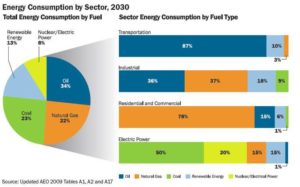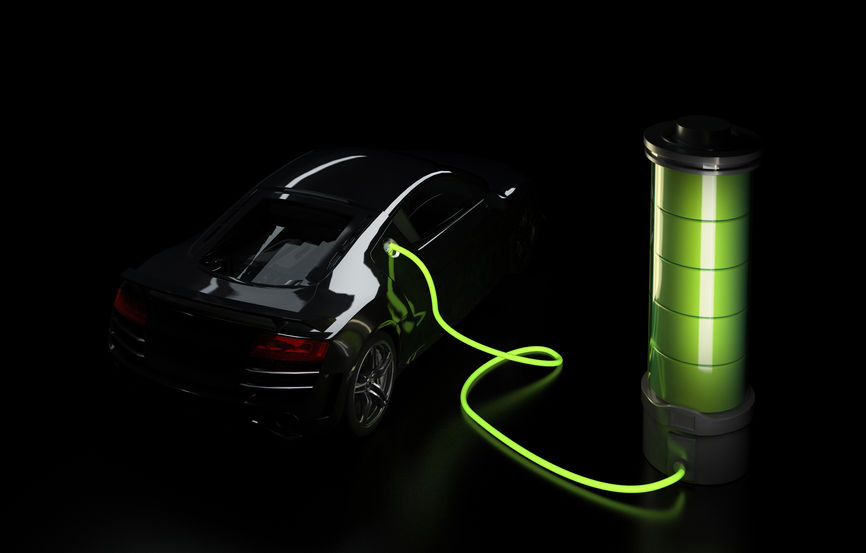Given all the hype over renewable sources to generate intermittent electricity, the numbers from the Energy Information Administration (EIA) support none of the biased hype. Fossil fuels dominate the energy mix today and are projected to do so for at lest a decade as shown in the figure below.
Yet over the past four decades billions have been spent on solar, wind, corn and other biofuels, not to mention electric cars which I will cover shortly. The result of all this investment been only a modest gain in market share. Part of this is the amazing number of other lifestyle products derived from petroleum. EIA has calculated that they number over 6000. An added disadvantage is that renewables have no role in the military, or for airlines, cruise ships or supertankers.
While conspiracy theorists may prefer to believe that big oil, coal and nuclear have stifled the growth of renewables, it is not so. Only coal, oil, natural gas and nuclear can satisfy the four energy imperatives, power density, energy density, cost and scale. Renewables fall woefully short of meeting these requirements.
The biggest impediment to the growth of electricity generated by wind and solar is the newly coined Ciccione/Lehr Rule of Thumb which states “All wind and solar power on the electric grid must be backed up by an equal or greater amount of fossil fuel power running on standby 100% of the time” It has been described in detail in numerous previous articles by this author at CFACT.org.
Let’s turn our attention to the most over looked source of energy coming to the fore daily, that which powers so-called electric cars. California plans to have over 25 million such vehicles in the not too distant future. The utility companies have thus far had little to say about the alarming cost projections or the certain increased rates that will be required to charge their customers. It is not just the total amount of electricity required but the transmission lines and fast charging capacity that must be built at existing filling stations. Neither wind or solar can support any of it.
A Canadian engineer recently ran the numbers involved in the switchover to electric vehicles and concluded that in order to match the 2000 cars that a typical filling station can service in a busy 12 hours, the filling station would require 600, 50 watt chargers at an estimated cost of $24 million and a supply of 30 megawatts of power from the grid which would be enough to power 20,000 homes. Unlike home recharging stations, these would be operating at peak usage hours where the rates are the highest. Can you spell brownout and blackout. Basically new grids will need to be built at the cost of billions.
No-one likely thinks about the fact that it can take between 30 minutes and 8 hours to recharge a vehicle, depending on it being empty or just topping off. They will need lounge areas, holding areas for vehicles completed but waiting for owners to return from shopping or dining.
There is no question that electric vehicles have some positive attributes, low refueling costs, no air pollutants at the point of use and quiet operation, but are they actually clean an d green as their marketing insists. They have no tailpipes, as we know, on the car, but immense exhausts miles away. Aren’t they really coal or natural gas cars? They are certainly not wind and solar cars .
d green as their marketing insists. They have no tailpipes, as we know, on the car, but immense exhausts miles away. Aren’t they really coal or natural gas cars? They are certainly not wind and solar cars .
Regardless of their promise they continue to be hampered by their long standing drawbacks, extra costs, limited range, slow recharge rates, lack of recharging stations and a relatively short battery life with a high replacement cost against the life cycle of the average internal combustion engined car.
Although the modern lithium-ion battery is four times better than the old lead-acid battery, gasoline holds 80 times the energy density. The great lithium-ion battery in your cell phones weighs less than an ounce while the Tesla battery weighs 1000 pounds.
Do we still think electric cars are the wave of the future?
Portions of this article have been excerpted from the book ENERGY MADE EASY with permission of the authors Ronald Stein and Todd Royal. Their book is highly recommended for tremendous detail about the world’s energy.
